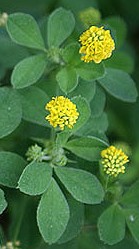 Black medic is an annual or short lived perennial weed that is actually beneficial. Its roots have the ability to take nitrogen from the air and put it in the soil, thus improving soil fertility. Although it is a native of Eurasia, it is found throughout the continental United States. It was once grown for pasture forage and as a cover crop but now is considered a weed especially in lawns. It also finds a home in the flower garden, roadsides and along driveways. It thrives in full to partial sun, and poor, moist to mesic soil, and can be considered an indicator of poor soil.
Black medic is an annual or short lived perennial weed that is actually beneficial. Its roots have the ability to take nitrogen from the air and put it in the soil, thus improving soil fertility. Although it is a native of Eurasia, it is found throughout the continental United States. It was once grown for pasture forage and as a cover crop but now is considered a weed especially in lawns. It also finds a home in the flower garden, roadsides and along driveways. It thrives in full to partial sun, and poor, moist to mesic soil, and can be considered an indicator of poor soil.
 Description: The stems of black medic are prostrate and grow up to 26” long radiating out from a central root. They are angular in cross section, branched, and covered with white hairs. The alternate compound dark green leaves are trifoliate and each leaflet is oval to egg-shaped and about 2/3’ long by 1/3” wide. The middle leaflet is larger than the lateral leaflets and on a stalk in contrast to the two lateral leaflets which are sessile. The stalk of the middle leaflet distinguishes this plant from other similar ones. Small yellow flowers are borne on stalks in clusters ½” to ¾” long beginning in spring and continuing intermittently until fall. Flowers are followed by seed heads bearing a one seeded, kidney-shaped, hairy, black pod that accounts for the common name. The root system is a fine taproot.
Description: The stems of black medic are prostrate and grow up to 26” long radiating out from a central root. They are angular in cross section, branched, and covered with white hairs. The alternate compound dark green leaves are trifoliate and each leaflet is oval to egg-shaped and about 2/3’ long by 1/3” wide. The middle leaflet is larger than the lateral leaflets and on a stalk in contrast to the two lateral leaflets which are sessile. The stalk of the middle leaflet distinguishes this plant from other similar ones. Small yellow flowers are borne on stalks in clusters ½” to ¾” long beginning in spring and continuing intermittently until fall. Flowers are followed by seed heads bearing a one seeded, kidney-shaped, hairy, black pod that accounts for the common name. The root system is a fine taproot.

 Control: Black medic can be aggressive but if it is not a problem you might consider leaving it alone so it can add nitrogen to the soil. It is easily pulled out by hand and if you don’t want a second crop, remove the plants or the flowers before seeds are produced. Plants usually die after a year in the garden with seeds being their only method of reproduction. When this weed shows up in an area it suggests that there is a soil nutrient problem. Once the soil is treated black medic will no longer be an issue. Non-selective herbicides are effective but not usually needed.
Control: Black medic can be aggressive but if it is not a problem you might consider leaving it alone so it can add nitrogen to the soil. It is easily pulled out by hand and if you don’t want a second crop, remove the plants or the flowers before seeds are produced. Plants usually die after a year in the garden with seeds being their only method of reproduction. When this weed shows up in an area it suggests that there is a soil nutrient problem. Once the soil is treated black medic will no longer be an issue. Non-selective herbicides are effective but not usually needed.